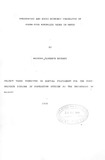| dc.contributor.author | Wachira, Florence N | |
| dc.date.accessioned | 2013-05-21T12:44:26Z | |
| dc.date.available | 2013-05-21T12:44:26Z | |
| dc.date.issued | 1998 | |
| dc.identifier.citation | Post- Graduate Diploma In Population Studies | en |
| dc.identifier.uri | http://erepository.uonbi.ac.ke:8080/xmlui/handle/123456789/24173 | |
| dc.description.abstract | The 1993 Kenya Demographic and Health Survey (KDHS~data was analysed using both direct and indirect methods to estimate child mortality rates according to maternal age at first birth, parity and preceeding birth interval. Trussel technique was used for analysis involving maternal age at first birth. Calculations of the
proportions dead under - five years among children ever born were done for parity and preceeding birth interval. An attempt was made to explain .variations In child mortality rates on the basis of education attainment and type of place of residence of the mother using of simple percentages.
The study found regional differences in under five mortality according to maternal age at first birth, parity and preceeding birth intervals. Education attainment may be correlated to child mortali ty only when the maternal age at first birth is 20+ years, parity 4+ and at preceeding birth interval in excess of four years.
The urban advantage and related influence on child mortality is observed only when age at first birth exceeds _ 20 years and for preceeding birth interval 4+ years.
The study recommended intensification of education for girls, both normally and non-formally, throughout Kenya to increase participation and completion rates up to secondary level. Further analysis should be done to determine the strength of correlation between the variables | en |
| dc.language.iso | en | en |
| dc.publisher | University Of Nairobi | en |
| dc.title | Demographic and socio-economic correlates of under-five mortality rates in Kenya | en |
| dc.type | Thesis | en |
| local.publisher | Department of Population Studies | en |

